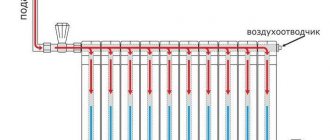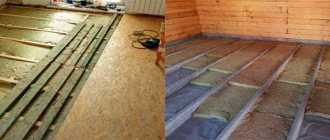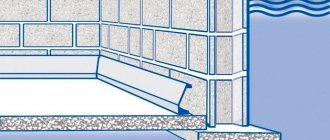Home/Water supply and sanitation/Replacement of risers in apartment buildings
Despite the fact that most residents are the owners of their apartments and pay for general building needs on a monthly basis, direct replacement of risers and other water supply elements is carried out by representatives of the management company (MC). Their actions are based on the regulatory framework of the laws of the Russian Federation. However, not many apartment owners know their rights if it is necessary to replace common communication elements located in their apartments.
The solution to replacing risers in an apartment building, the identification of responsible persons and the rules of behavior in conflict situations will be given below.
Normative base
The regulatory framework for the replacement and repair of the water supply system is regulated by:
- rules for the maintenance of property located in the common possession of the apartment building (RF RF No. 491 dated 08/13/20016);
- standards for the technical use of housing stock (Resolution of the State Construction Committee of the Russian Federation dated September 27, 2003 No. 170);
- methodological manual for the operation, maintenance and repair of housing stock MKD 2-04.2004.
How to assemble a new riser
The new riser is assembled from the bottom up. All sections are polished, removing burrs. This is done to prevent uneven surfaces from becoming debris collecting areas. Fasteners are installed under the sockets; clamps are used for this. The riser is fixed to the wall.
If polypropylene products are installed, use a compensator (pipe). It is put on a cut of an old pipe. At the final stage, the straight section is connected to the pipe. The pipe may not fit well into the socket; in this case, its edge is lubricated with soap.
When the installation work is completed, all joints are carefully coated with sealant.
Who should change risers in an apartment building?
It is a mistake to believe that if the common water risers are used by the residents of the apartments of an apartment building, then the responsibility for replacing them rests entirely with them. Ignorance of the regulatory framework of the Housing Code leads to unnecessary waste of money from the pockets of owners.
Attention
Decree of the Russian Federation No. 354, Article 149 (dated May 6, 2011) and Article 161 of the Housing Code of the Russian Federation state that repairs, as well as complete replacement of risers in an apartment building, are the responsibility of the Management Company assigned to a specific building.
Every month, each apartment owner receives a receipt for utility bills, which contains the column “maintenance and repairs.” For those funds that come from residents from paying receipts, in particular for maintenance and repairs, all preventive and repair work must be carried out.
Consequently, in the event of a pipe break or other damage to the riser, the housing office is obliged to carry out repair work without charging residents (the reverse action is illegal).
When to change
Cast iron risers, due to their gentle operating mode, in which their contact with liquid waste occurs only briefly and the falling flow does not completely wash the walls, work in sewer systems for quite a long time. In multi-storey buildings on the upper floors, a cast iron riser will last much longer and will become less clogged, unlike the first floors, where the riser drain is in contact with the liquid for a longer time. The need to replace the riser may be caused by the following reasons:
- Physical deterioration . During operation, the walls of cast iron risers become thinner due to low corrosion resistance, cracks and fistulas form in them, pipes leak, and there is an unpleasant odor in the bathroom.
- Frequent blockages . With prolonged use, the inner shell of pipe risers becomes covered with plaque; over time, its thickness increases - this leads to the fact that the throughput of the pipeline decreases and in emergency situations the passage channel becomes clogged.
Rice. 2 Damaged drain pipe
- Mechanical damage. Cast iron is a brittle material; when struck by sharp, heavy objects, it splits and cannot be repaired. When carrying out major repairs, situations sometimes arise when the old internal sewer pipeline of an apartment in the inlet pipe of the riser is broken, and the shaped element (tee, cross) may crack. The adapter from the internal sewerage system to the riser cannot be restored - it must be replaced, and the riser pipe will also have to be removed, and if it is very worn out and clogged with plaque, it must be replaced.
- Repair. When carrying out renovations in an apartment, it may be necessary to replace the tee in the sewer riser that supplies wastewater to a vertical pipe to change its configuration, using modern PVC products. In this case, it is easier and more reliable to install a plastic product instead of an old worn-out cast iron pipe, which is not intended for joining with shaped polymer parts.
- Noise insulation. If an inexpensive PVC pipe riser is installed in the house, when using the sewerage system, noise often occurs in it, reducing the comfort of living and using the toilet. One of the radical options for combating sewer noise is to replace the vertical riser pipe with a low-noise, specially designed one that has a higher mass and, accordingly, cost.
Rice. 3 Low noise sewer pipes
Replacement standards
According to the standards for replacing risers in an apartment building, they must be replaced in two cases:
- Expiration of the operational life of the metal structure.
- Complete renovation of the apartment's bathroom.
Living conditions provide for 2 modes of pipe replacement:
- planned - when the time for replacement has approached;
- emergency - when the integrity of the pipe has been damaged and a leak has formed.
IMPORTANT
The warranty period for pipes in apartment buildings is at least 25 years. Even if after this period the structure is intact without leaks, the riser still needs to be replaced.
Increasingly, cast iron pipes are being replaced with polypropylene ones. This is due to a number of advantages of the material:
- efficiency;
- ease;
- strength;
- environmental safety;
- resistance to deformation from thermal effects;
- resistance to corrosion and other influences;
- sliding structure of the internal walls, which prevents plaque formation;
- long service life: from 50 to 100 years.
Important Tips
When carrying out operations to replace the riser with your own hands or with the help of plumbers, it is useful to adhere to the following recommendations:
- The main reason for replacing a cast iron sewer riser is frequent blockages associated with low channel permeability, or significant damage in the form of cracks and falling out fragments . All other malfunctions in the form of leaks, fistulas can be easily eliminated with your own hands using sealing materials: cold welding, epoxy resin and others. Large damaged areas can be covered with applied rubber cuffs secured with clamps - due to the low pressure in the sewer line, high strength patches are not required to repair any damage.
- Many novice and experienced plumbers carry out meaningless manipulations with sealant, covering cuffs and rubber seals in pipes with it. The sealant is intended for sealing cracks and seams between hard surfaces and is not an adhesive; when deformed, it will not adhere to elastic rubber and will even cause harm, preventing the rubber seal from fitting tightly to the pipe casings.
- When installing brittle plastic into a vertical gap in a cast-iron sewer line, there is a high probability of it being compressed by the upper column; to eliminate the danger, measures should be taken to additionally secure the upper pipe. Its protruding end is attached to the wall with additional clamps; if possible, you can coat the shell with concrete contact, special glue, and wall up the free area in the wall using materials with good adhesion to cast iron or its new coating.
- In order not to waste a lot of time when dismantling the old and installing a new riser, it is better to caulk it in advance without removing the pipes. Using a chisel or a sharp screwdriver, knock out the most common cement putty at the top and bottom; if a leak suddenly appears, it is temporarily sealed with plasticine.
Rice.
12 Price list for the services of one of the companies Replacing a cast-iron riser pipe with a plastic one can be done with your own hands; the task is greatly simplified if the apartment is located on the upper floors and the caulking is done poorly using fragile materials. To install a polymer riser, you will need a pair of transition couplings from cast iron to plastic, a cross or tee, a piece of pipe of suitable length, in addition to the standard construction tool in the form of an angle grinder and a hammer drill, you may need a blowtorch.
What is included in replacing risers in an apartment building?
The process of replacing a riser in an apartment building is the direct removal of the old structure for a new one. However, this is not all that is included in the concept of “replacing a riser in an apartment building.”
Attention
First, you need to contact the management company and write an application to replace the pipe. The applicant will receive a satisfactory answer if the document is drawn up correctly and the facts supporting it do not raise doubts.
On the appointed day, representatives of the management company turn off the water in the risers and drain the remaining water. After this, craftsmen come from the management company or organization with which the management company has entered into an agreement. They carry out all the necessary procedures for replacing a faulty riser pipe in an apartment building.
- The master uses a grinder to cut out old pipes.
- Makes markings for new branches.
- New pipeline structures are being installed.
- They run water to check the tightness of all joints of the new riser.
By law, all necessary elements of the communication system that need to be replaced are delivered to the owner’s apartment. However, situations are not uncommon when the tenant himself, in whose apartment the installation is to be carried out, pays for all consumables and the element of the new pipe itself. By law, all expenses of the owner must be included in the payment of the receipt for the maintenance of common property for the next month.
Features of connecting to the wiring
In the place where the vertical pipeline will connect to the wiring in the apartment, install a tee measuring 32/20/32. To facilitate installation of the tee, its end is lubricated with liquid soap. The elements are fixed by soldering.
When planning to install a heated towel rail in the bathroom, two additional tees are installed on the pipeline
An important point: when installing tees, it is preferable not to use a coupling, but a soldered connection.
After installing the shut-off valve, check for leaks. If there is none, fix the assembled structure to the wall.
To do this, using a building level, pre-mark points in the wall for making holes for installing clips. Fastening elements are placed every 100-150 cm.
From the moment the last connection is made, the installed section of the network can be filled with water no earlier than an hour later. To ensure a sufficient level of moisture resistance and sound absorption, the places where pipes pass through the ceilings are concreted throughout the entire thickness. These and other finishing activities are carried out only after testing the structure.
Step-by-step instructions for replacing risers in an apartment building
A break in the water riser in one apartment requires its immediate replacement. Before carrying out repair work, the owner of an “emergency” apartment must discuss this action with the neighbors of the upper and lower floors. The fact is that the pipes are in a worn state along their entire length, despite the fact that the breakthrough occurred in a certain place. And for reliability, they should be replaced completely, in all apartments. If the neighbors disagree, the installation of a common water supply channel will be carried out only in one apartment.
The next step is to contact the Criminal Code. Their powers include shutting off the riser and draining the water. Next, complete or partial (in a separate apartment) installation of pipes takes place.
According to VSN 58-88 (r) “On the organization and implementation of reconstruction, repair and maintenance of buildings, public utility and social-cultural facilities,” planned replacement of water supply systems should be carried out every 25-30 years. Repair work is carried out inside privatized and non-privatized apartments, as well as in basements and entrances.
Which pipes to choose
When the riser is replaced, instead of cast iron pipes, polymer pipes made of polypropylene or polyvinyl chloride, or less often polyethylene, are installed. They have the following properties:
- Polypropylene is often used for indoor sewerage. Pipes made from it are durable and can withstand temperature changes.
- Polyvinyl chloride is durable and UV resistant. When heated, PVC begins to release harmful substances, but is suitable for sewage.
- Polyethylene is durable, pipes withstand water hammer well.
- The inner surface of all types of polymer pipes is smooth, which provides less opportunity for the formation of blockages and build-ups.
Plastic products have shaped parts for connecting elements. A socket is made on one side, into which the end of the next pipe or tee is inserted. A reliable seal is ensured by a rubber ring.
If necessary, shorten the product using a hacksaw. The cut end is chamfered so as not to damage the cuff when joining. Be sure to remove any hangnails from the inside, otherwise impurities will cling to them, gradually increasing in volume.
In some cases, owners prefer to replace the old cast-iron riser with a new one made of the same material. They are attracted by the durability of cast iron and reliability. Some people think that they will encounter difficulties joining plastic to metal. There are no difficulties here: there are special adapters.
Replacing a sewer riser
The sewer riser belongs to the common property of the house, even though it passes through a private apartment (according to Article 290 of the Civil Code). Also, the RF PP No. 491 clause 5 dated 08/13/2006 states: “... the common property includes the drainage system, that is, the sewerage system...”.
Consequently, the management company is responsible for the installation and repair work of the sewer riser in an apartment building. For all the necessary consumables that will be required during the replacement process, as well as for the repair itself, apartment residents pay for it, paying monthly sums of money for receipts with the column “maintenance and repair of housing.”
IMPORTANT
On the day the sewer riser is replaced, the apartment owner does not have to pay anything.
But, if previously the owner of the apartment independently replaced the sewer pipe, and this fact is proven, then the owner is obliged to fully pay for the subsequent installation of this element of the communication system.
Before starting repairs to the sewer riser of an apartment building, a resident must:
- Visit the management company and leave an application for replacement of the emergency element.
- Draw up a report with a representative of the service organization, which will describe the condition of the sewer riser and (recommended) attach a photo.
- Specify the date and time of the work to be carried out, and notify neighbors about it in a timely manner.
- Determine the material of the structure that will be installed in place of the old one, as well as some nuances.
At the appointed time, repairmen come and carry out all the necessary actions to replace the sewer riser.
For your information
Upon completion, a “Certificate of Work Completed” is drawn up between the management company and the repair organization. The owner of the apartment should also keep a copy of this act.
How to change it yourself
Partial or complete replacement of a cast iron riser is possible only with a plastic analogue, this is due to the fact that during installation the riser column is installed from the bottom up with pipes on top of each other in the nozzles, and to replace one of the fragments, a special compensation coupling is required, which allows inserting less than long pipe. Such products are difficult to find in shaped elements for the installation of cast iron, but they are produced in a wide range in the PVC pipe product line.
Tools and components
Before replacing the sewer riser in an apartment, purchase the following components:
- A plastic pipe along the height of the riser with a standard outer diameter of 110 mm.
- A typical cross with two 50 mm outlets for connecting drain pipes in the bathroom and kitchen sink and with one outlet for connecting a toilet. If the apartment has only one common outlet for transporting gray waste, use the appropriate tee.
- Rubber cuffs (in the absence of adapters from cast iron to plastic), one will be needed when installing a cross (tee) into the neck of the lower cast iron pipe, the other is put on the outside on the pipe end coming out from above.
Rice. 6 Single-pipe sewerage distribution inside the apartment
- An expansion coupling, which is a piece of pipe with an elongated expanded pipe with an internal diameter of 110 mm - thanks to this, the inserted pipe element can be moved within it over a certain distance.
- A transitional plastic coupling with a built-in cuff, which, if necessary, is installed in the socket of the lower sewer pipe and serves to adjust the cross to the required height if it is impossible to directly connect it with a cast iron saddle recessed in the floor.
- A transitional PVC coupling from plastic to cast iron with a rubber cuff inside the socket for the upper connection, its lower end is inserted into an expanded pipe with a rubber ring of a vertical plastic pipe.
- Metal clamps with rubber gaskets with an internal diameter of 110 mm, designed for fastening plastic riser pipes to the wall.
Rice.
7 Tools From plumbing and construction tools you will need to carry out the work:
- Angle grinder (grinder) with a metal disc for cutting cast iron and plastic pipes.
- A hammer drill for drilling holes in the wall, removing screeds and cement caulking in cast iron joints.
- Chisel, chisel, heavy hammer or sledgehammer for caulking joints and breaking cast iron pipes.
- Pencil, tape measure or ruler.
- A blowtorch for melting caulking materials - sulfur, lead, epoxy resin, is used in case of incomplete replacement of the riser, if it is necessary to leave the cross or part of the pipe intact.
- Protective clothing, gloves, glasses, respirator.
Rice. 8 Dismantling a wall riser - basic operations
Dismantling and caulking
When joining cast iron riser pipes, a pipe connection was previously used, in which a variety of materials were used to seal the joints instead of a rubber seal. Workers carried out the joining using various methods, depending on the technology adopted in the organizations: poured molten sulfur or lead into the cracks, laid fabric and coated the outside with thick cement, poured epoxy resin, pushed in a cord or rope soaked in bitumen mastic.
The main task of dismantling is to destroy the cast iron pipe connection using several methods. Depending on the sealing material, it is carried out in the following sequence:
- Before starting work, be sure to visit all neighbors on the floors above and ask them not to use the kitchen sink, bathtub, and toilet for some time.
- The toilet is removed and put away; to do this, disconnect the corrugation from the riser outlet, having first drained the water from the tank and shutting off its flow with the tap below, unscrew the toilet mounting screws and the supply hose, and take the toilet outside the sanitary unit.
Tip: After removing the toilet, be sure to lean the tank against the wall - otherwise, under the weight of the flush tank, it will turn over and most likely break.
Rice. 9 Methods for caulking cast iron joints
- Using a puncher, knock down the screed at the bottom, freeing and cleaning the junction of the cross with the pipe; if the solution from above interferes with dismantling and covers the outer shell of the exiting pipe, it is also knocked out.
- Use a grinder to cut the vertical pipe of the riser in the transverse direction at any convenient distance from the floor (about 0.5 m, so that you can place a bucket under the pipe); if it is impossible to get close to the pipe shell near the wall with a machine, use a practically used metal disc of small diameter. It is not necessary to make a through cut - if the pipe is not needed, it is subsequently broken with a heavy sledgehammer or hammer.
- Insert the chisel into the seam on the pipe obtained from the grinder disk and hit it forcefully with a hammer, trying to break the body; after it bursts, remove the fragments to the side. To avoid unexpected water flow from above, despite the warning, place a bucket under the cut pipe.
- They try to pull the cross out of the pipe of the lower pipe (you should be careful here; if the riser is broken, the expansion pipe may be damaged); if this presents difficulties, they use various methods of disconnection.
Note: When cement-sand sealing, the mortar is knocked out with a hammer and chisel, the frozen sulfur, lead, soaked rope and epoxy resin are heated and melted with a blowtorch, after which the crosspiece is pulled up.
- After dismantling the crosspiece, clean the lower pipe from dirt and debris to avoid blockages and begin dismantling the upper section of the pipe. It is pulled down, if resistance is encountered, the outer pipe is heated with a blowtorch, the shell can be carefully broken with a hammer, being careful not to damage the end of the riser coming out from the ceiling.
- After dismantling work, a fragment of the shell of the upper cast-iron pipe should remain on the ceiling, and in the floor there should be an expanding pipe of the lower pipe with the outer and inner surfaces, respectively, cleared of dirt.
If none of the above methods fails to remove the lower tee or upper pipe, they are cut with a grinder and adapters or couplings of a suitable outer or inner diameter are selected.
Rice. 10 Assembly diagram with examples
Installation of a new riser
After preparing the end sections of the inlet and outlet cast iron pipes, they begin to install the plastic riser, in which case it is necessary to join the cast iron and plastic pipes with internal bore diameters of 100 mm. The outer diameter of a standard cast iron pipe is 118 mm, the internal size of its cone-shaped socket is 123 - 127 mm. The plastic sewer PVC pipe has an outer size of 110 mm, and the inner diameters of the shell are 100 mm, and the socket is 110.4 mm.
It follows from this that to connect the PVC pipe at the top you will need an adapter from plastic to cast iron with outer and inner diameters of 110x120 mm, respectively, and a built-in rubber cuff. If the tee is being replaced from below in a sewer riser, the adapter from plastic to cast iron should have dimensions of 110x120 mm (inner and outer diameter) and an outer cuff, which is inserted into the cast iron socket (Fig. 10).
Installation of the riser is carried out in the following sequence:
- Place a transition coupling from plastic to cast iron with an internal rubber seal on a section of cast iron pipe protruding from the ceiling.
- Install a cross with a rubber cuff into the saddle of the lower cast iron riser; if necessary, install an adapter from plastic to cast iron with a similar seal.
- Place a vertical riser PVC pipe into the gap between the upper and lower sections, cut it 30 - 50 mm shorter, and put an expansion sleeve on its lower end until it stops.
- Place the assembled system vertically in the riser; if the length is too long, the pipe is further trimmed. After the ends of the structure coincide in height with the inlet and outlet openings, the compensation pipe is lowered down the pipe, immersing it in the tee at a distance of 30 - 50 mm.
- The riser is secured with rubber clamps to the mating part of the clamps with screws screwed into the wall in advance, the distance between the fasteners is about 400 mm.
Rice. 11 Installation of the riser
Payment for replacement
The answer to the question regarding payment for replacing a riser in an apartment building is contained in Government Decree of the Russian Federation No. 491 dated August 13, 2006. The document determines what is common property, who is responsible for its maintenance and accordingly pays for its repair and replacement.
According to PP No. 491 and its section “Rules for maintaining the property of an apartment building,” each apartment owner pays for the maintenance and repair of all communications in the building. The same information is contained in Article 158 of the Housing Code of the Russian Federation “Expenses of owners of premises in an apartment building”: all owners of apartments in apartment buildings are involved in the costs of maintaining and repairing common property.
Thus, all costs for replacing the water supply riser in an apartment building are paid by the housing and communal services from the funds that all apartment owners contribute monthly, depositing money for receipts for the maintenance of common property.
Preparation for work and tools
For dismantling you will need sledgehammers, hammers, grinders, and a hammer drill. It may take several discs for an angle grinder; the work is quite exhausting.
In some cases, a gas torch or blowtorch may be required.
Tools for replacing the riser
Chisels, special hammer - chisel, screwdrivers, metal wedge, silicone sealants. You will also need stepladders or sawhorses. It is highly undesirable to carry out work on dismantling cast iron sewer pipes alone.
Materials for work
- Rubber cuffs - seals to ensure tightness of joints with a cast iron pipe, if provided;
- 11 cm plastic tee or cross;
- Sewer plastic pipe 110 mm. Be sure to check the labeling that this is the sewer option. This point is important because sewage effluents have a high level of aggressiveness. In addition, the pipe must be resistant to acid- or alkaline-based cleaning agents;
- Pipe diameter compensators;
- Plastic adapters with cuffs;
- Clamps and fastenings for pipes;
- Plastic bends for possible alignment of the riser.
Plastic pipe for internal sewerage 110 mm
Don't forget about personal protection. Thick construction gloves and mittens and safety glasses are required. You will also need a respirator with a fresh filter or a gas mask. Wearing work clothes with tight and soft knee protection will help you prevent the development of joint diseases.
The water supply must be shut off throughout the entire riser. Notices should be posted at the entrance in advance to warn residents. It is advisable to also visit all apartments and notify additionally about the time of work.
What documents are issued to the property owner?
Upon completion of the installation of the MKD water riser pipe, a “Certificate of Work Completed” must be drawn up, which will state the following:
- date of drawing up the contract;
- serial number of the agreement according to which the act is issued;
- the volume of work performed and all actions taken;
- cost of work;
- name of the person performing the repair work;
- signatures of the contractor and the customer.
This document is made in 2 copies, one of which is given to the contractor, and the second remains with the customer. The contractor is the organization that replaces the damaged element. The customer can be the management company (in which case one copy remains with them and is not given to the owner of the apartment) or directly the owner of the property.
Even if the agreement was drawn up by a representative of the management company and the repair company, the apartment owner should make himself a copy of this act.
approximate price
The average cost of replacing 1 riser in central Russia ranges from 2,500 rubles for plastic pipes without passing through the ceiling , to 5,000 rubles with passing through the ceiling.
Replacing with any metal ones will cost 2,000 - 3,000 rubles more. In Moscow the price is 1.5 - 2 times higher. The approximate cost of work in a simplified form is shown in the table:
| Name of works | Cost, rub. |
| Dismantling the riser | 500 — 1000 |
| Riser installation | 1000 — 2500 |
| Passage of 1st floor | 500 — 800 |
| Passage of the 2nd floor | 500 — 800 |
| Cost of materials | 1000 — 1500 |
| Total: | 3500 — 6600 |
| Additional costs are possible for disconnecting, connecting, crimping the riser, sealing the water meter | At UK prices |
When discussing the final price, you should focus on market prices in the region, and not on the estimate provided by the contractor. The estimate can easily justify a cost that is many times higher than current prices.
Is it possible to refuse to replace risers in an apartment building?
“Is it possible to refuse to replace the riser?” - a pressing question for those residents who have undergone a major renovation of the apartment, because the proposed general house procedure implies some damage to the owner’s property in the bathroom. Is it possible to write a refusal?
Based on the information contained in clause 5 of PP No. 491, risers in apartment buildings are common property. According to the law, none of the residents has the right to prevent representatives of the contractor (MC), as well as emergency services, State control and supervision authorities from inspecting the current condition of communication equipment and carrying out repair work. A control inspection should be carried out no more than once every 90 days, and in case of an emergency - at any time.
Thus, apartment owners do not have the opportunity to refuse to replace common communication systems in an apartment building. In response to the refusal, the management company or HOA has the right to sue.
Who can carry out the work?
With the direct management method, the owners themselves determine who can be allowed to carry out work.
Most often, this decision is made by the apartment owner alone. In the future, all responsibility for the defect and damage caused will lie with him or with the organization that performed the work under the contract.
In a house with a management company, work to replace risers is carried out with the consent of the management company, since it is responsible for their safe operation.
Depending on the position of the head of the management company, the following may be allowed to work:
- qualified employees of the management company itself;
- specialized organizations or individual entrepreneurs;
- a private person with the appropriate qualifications.
The responsibility to check the specialization of the organization and the qualifications of its employees lies with the management company.
But the apartment owner should not neglect this either. Especially in terms of control during the execution of work.
The following documents or their copies certified by the head of the organization can serve as confirmation of specialization:
- extended extract from the Unified State Register of Legal Entities indicating the types of activities;
- documents on certification of responsible persons issued by Gostekhnadzor, the qualification commission of the organization itself;
- information on the official website of the organization;
- order for the enterprise on assigning qualifications to an employee.
Attention! Often, owners themselves carry out work to replace the riser, and even without the consent of the management company. In this case, in addition to compensation for damage, there may be administrative liability for damage to water supply networks, and in case of significant damage, even criminal liability.
Possible conflicts and their resolution
When replacing a riser in an apartment, its owner may encounter situations that prevent repair work . Conflict cases may be as follows:
- Refusal of the management company to replace faulty equipment.
- Neighbors disagree with replacing the riser in an apartment building.
There is no point in delaying their decision, especially if replacement of the emergency element is required in the very near future.
When contacting the management company with an application to replace the riser in an apartment building, you may encounter a refusal to carry out the work. The reasons may be different, but most often the management organization refers to the serviceability of the communication system. In this case, the owner has every right to sue the management company, as well as to recover monetary compensation from them for the damage caused.
A common emergency pipeline often leaks not only in one apartment, but also in neighbors above or below. Or the riser is in unusable condition and requires a total replacement, and not just a separate “fragment”. Therefore, installation should be carried out in several apartments. But there are often cases when some of the owners refuse to carry out the necessary work.
It is possible to solve the problem through conversations, but they do not always lead to the desired result. In this situation, the best solution would be a trial. But it is not other apartment owners who must apply to the court, but the management company. In his application to the judicial authorities, the representative of the management company puts forward a demand to the court to force the owner to replace the riser.
For your information
Litigation is not a quick process, but it is effective. According to his decision, the owner obstructing the repair undertakes not only to allow repairmen to replace the pipe, but also to install the concealing box (if there is one). The judge can significantly speed up the process of the case by satisfying the plaintiff’s request in accordance with Art. 212 of the Civil Procedure Code.
General rules for independently replacing water supply and sewerage pipes in an apartment
In most cases, independent replacement of pipelines is carried out before an emergency. The owner has a desire to replace metal pipes with more modern materials and make changes to the layout of the bathroom.
The old sewer system does not satisfy many:
- frequent blockages;
- specific smell;
- loud sound from the drain.
Grease settles on the surface of cast iron pipes, reducing throughput. The most dangerous place is the tee, which, due to settled food residues, begins to corrode, cracks, leaks, and flooding of neighbors appear. Prevention helps little, radical measures are needed - replacing the riser completely or individual elements.
When carrying out independent work, you must:
- notify the housing office, regardless of the fact that the replacement is carried out at personal expense;
- personally tell your neighbors and ask them not to use the sewer;
- turn off the water in the riser.
- It is better to choose a working time for repairs, when there are a minimum number of residents in the house.
Before installation, pipes of the appropriate diameter and other necessary elements are purchased. They start by dismantling old communications and installing new ones. Instead of steel and cast iron, plastic ones are installed. This is a material used in modern homes. Pipelines are installed openly or hidden in walls. The closed option may cause inconvenience if the system does not work properly. Then you will have to remove the lining and get to the riser.
Polymer pipes, like cast iron, have a socket. Each is secured to the wall by the neck with clamps to avoid uncoupling. The joints are sealed. This will prevent leaks and odors. For metal pipes, use oil-impregnated cord. The plastic elements are sealed with rubber rings. After installing the pipes, the plumbing is connected.
Complaint about poor quality replacement of risers in an apartment building
If the emergency riser is replaced poorly, the apartment owner has the right to file a complaint against the organization responsible for this matter. The complaint is submitted in writing to the State Housing Inspectorate of a specific region of Russia. It indicates the name and address of the owner where the emergency water riser is located.
The complaint consists of a statement and a request. The application must refer to Art. 161 of the Housing Code of the Russian Federation “General requirements for the management of an apartment building” and indicate that the repair work did not eliminate the emergency situation. The petition contains the applicant’s request to oblige the management company to correct the problems in accordance with the standards.
It would not be amiss to attach to the complaint photographic materials proving poor quality work, as well as an act drawn up between the tenant and the management company.
Caulking a cast iron pipe
A cast iron riser can be fixed in a socket in two main ways:
- Caulking the riser using carbolic acid and soaked rope.
- Caulking using sulfur filling.
Sealing pipe joints with sulfur
To find out, you need to try to loosen the pipe by tapping it with a rubber sledgehammer. If the pipe began to flow almost immediately, then carbolic acid was used. You must continue to gently swing the pipe and pull out the soaked rope with pliers.
If sulfur was used, strong impacts may damage the riser. Using a blowtorch or gas torch, the pipe is heated at the junction in a circle.
Sulfur vapors are poisonous. Be sure to wear gas masks and ensure the room is ventilated.
Warm up the pipe, softening the sulfur mass that seals it, and continue swinging. It is convenient to hold the pipe with pliers or an adjustable plumbing wrench.
After the pipe has been removed, clean the bell seat from any remaining sulfur or carbolic acid. When using chisels or chisels, be careful not to break the bell.
All this long vigil with the loosening of the pipe can be avoided by simultaneously replacing the riser. Old pipes are broken up, removed and transported. Together with sulfur, carbolic acid and bells. New ones are installed in their place. The space between floors is filled with polyurethane foam. Even sound insulation is improved.
Pipes made of polyvinyl chloride are increasingly used for laying external sewers, since they do not form plaque or rust, and they are also low in cost. Read carefully - PVC pipes for external sewerage: features of installation and installation in the ground. Read about how to properly solder various types of plastic pipes in this article.
Price list for additional work
| Name of works | price, rub. |
| Additional work with pipes | |
| Installation of the collector (comb), replacement of the comb in a ready-made place with pipes already connected | from 1400 |
| Installation of a ball valve (under a sink, under a toilet, corner with a screen, on a riser), pcs. | 500 — 2000 |
| Installation of pressure regulator (reducing valve), pcs. | 800 |
| Replacing the fitting (fixing leaks) | 500 |
| Wall chipping up to 10 cm thick. | 500 — 1000 |
| Repairing pipe leaks | from 1600 |
| Pipe dismantling | |
| Dismantling of water supply and sewerage pipes | from 400 |
| Dismantling the comb | 500 -1000 |
| Dismantling the ball valve, pcs. * | 400 |
| Removing the pressure regulator, pcs. | 400 |
| Installation of a floor-standing toilet or wall-hung toilet and a button (without installation), pcs. | 3700 |
| Installation of a wall-hung toilet (with installation), pcs. | 4600 |
| Installation of an installation system for a toilet, pcs. | 2700 |
| Tank installation | 1200 |
| Installation of a hygienic shower with mixer | 2200 |
| Mixer installation | |
| Installation of mixer (herringbone or single lever), pcs. | 1300 — 4000 |
| Installation of a mixer with a shower head (in the bathroom), pcs. | 2000 — 4000 |
| Installation of wall-mounted mixer with thermostat (temperature regulator), pcs. | 2000 — 4500 |
| Installation of touchless mixer (electronic), pcs. | 2500 — 6000 |
| Installation of a concealed mixer (including wall slitting, pipe laying), pcs. | from 5500 |
| Sink installation | |
| Sink installation, pcs. | 1500 |
| Installation of a sink with a pedestal (Tulip type), pcs. | 1800 |
| Installation of a siphon for a sink (without installing a sink), pcs. | 800 |
| Installing a “Water Lily” sink above the washing machine + connecting a mixer | 1600 — 3000 |
| Installing the sink on brackets + connecting the mixer and siphon | 1500 — 3500 |
| Installation "Moidodyr" | 2300 — 3500 |
| Hole in ceramic | 700 |
| Installation of heated towel rails | |
| Installation of a water heated towel rail on a ready-made connection (without adjustment), pcs. | 1800 — 3000 |
| Installation of a water heated towel rail on a ready-made connection (with adjustment), pcs. | 2500 — 5000 |
| Installation of an electric heated towel rail, pcs. | 2500 — 5000 |
| Moving a heated towel rail to another wall, pcs. | from 4000 |
| Installation work | |
| Foaming a metal bath | 1000 |
| Installation and connection of a cast iron bath | 3700 |
| Installation and connection of a bathtub (acrylic\metal) | 2500 |
| Installation and connection of an acrylic bathtub with a screen | 2800 |
| Installation of a bathtub with hydromassage | 3800 |
| Hydromassage connection | 1500 |
| Waterproofing bathtub seams (sealant) | 800 |
| Installation of a plastic screen | 700 |
| Installation of a shower cabin with hydromassage without mod. sealant | 5500 |
| Installation of a shower cabin without hydromassage without sealant treatment | 4500 |
| Waterproofing glass curtains | 1500 |
| Waterproofing shower cabin seams | 2000 |
| Installation of glass curtains/doors (one leaf) | 7000 |
| Installation of glass curtains/doors (double-leaf) | 9900 |
| Installation of a tray on the floor (ceramic) with connection to the sewerage system | 2500 |
| Installation of a tray on the floor (acrylic or iron) with connection to the sewerage system | 2500 |
| Waterproofing pallet seams with sealant | 600 |
| Bidet installation | 1400 |
| Installation and connection of a urinal with internal supply | 2500 |
| Installation and connection of a urinal with external supply | 2200 |
| Installing the bidet cover (electronic seat) | 2200 |
| Installation of toilet fittings | 500 |
| Installing the toilet seat (lid) | 500 |
| Installation of a panel with flush buttons | 500 |
| Connecting a washing machine | 800 |
| Dishwasher connection | 800 |
Difficulties with the law when doing independent repair work
There is no ban on changing the riser yourself, as such, but there are nuances. Residents are allowed to repair common property on their own using their own money, but before starting work, they will have to inform the management company that the owner wants to deal with his riser on his own, and also obtain permission from the neighbors through whose apartments communications pass. It is difficult to get permission from the management company, because the owner is often not a specialist.
If you decide to change the riser without the knowledge of the management company and other neighbors, then such an operation will be considered illegal, and the owner who carried out the secret replacement risks receiving a subpoena from his management company.
Check out other materials on our website about water supply and the problems that arise with it. Read about what standards of water quality and pressure, under what circumstances the resource can be turned off, how to pay for water according to standards and meters, what standards are without meters, as well as about the recalculation procedure and what to do if the water pressure decreases weak.
.
Planned home renovation
How to change the water supply system during a major renovation of an apartment? The event is long-awaited for everyone, but a lot of resources are spent, and most importantly, there is a lack of a flexible approach to all residents of this house. It would seem like a job that takes a couple of hours in an established system: remove old pipes and weld new ones, but in reality it’s not so simple. Residents of the house must give consent (usually this is only 30-40% of the residents) and are required to be at home during the work and wait their turn.
Practice shows that this happens in one case out of ten. As a rule, replacement of the water supply of a house is carried out at intervals, taking three apartments located vertically. And as you might guess, it is not always possible to come to an agreement with neighbors about carrying out work - some have fresh renovations, tiles have been laid, others are at work, and so on.
Ultimately, the time for the allotted event comes to an end, without reaching an agreement with the neighbors, your pipe is welded on top of the worn-out riser, reports are signed and the work is supposedly done! And you are left with a time bomb, with daily use.
Types of repairs
When troubleshooting and preventing the system, routine repairs are performed, usually its cost is included in utility bills. If you want to replace pipes due to rusty drips or regularly clogged risers, you must not forget about the restrictions and legal aspects. Therefore, we strongly recommend that you still turn to specialists; we tackle such tasks like crazy.
Photos of bathroom renovations and pipe replacements
What you need to know:
- legal side - part 1 of article 25 of the Housing Code of the Russian Federation, these changes require approval;
- Great responsibility, since water supply risers are common property;
- water pressure and temperature depend on the type of water supply and even on the type of your home;
A major overhaul involves a complete replacement of the entire hot and cold water supply network.
When approaching this issue, you must be fully competent in this difficult issue, and our team of professionals will be happy to share their experience and promptly correct any shortcomings.











